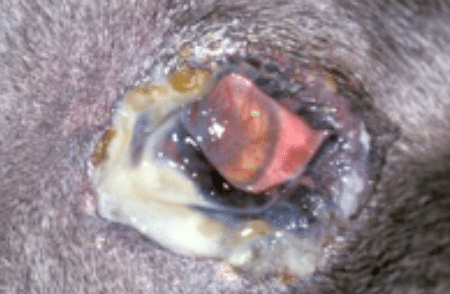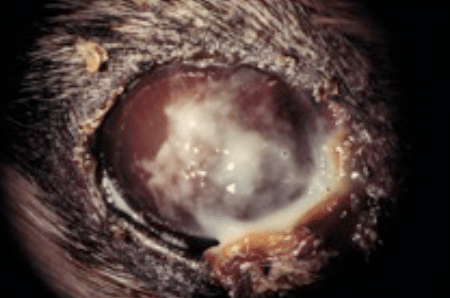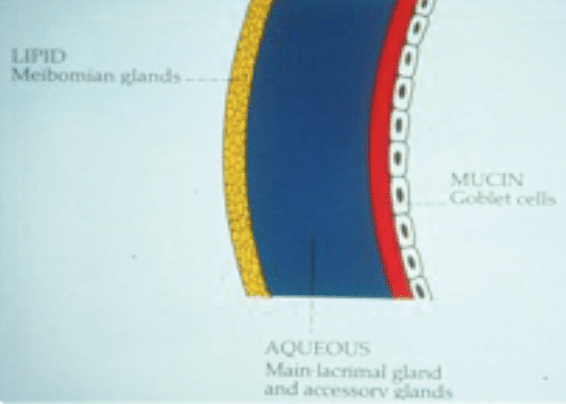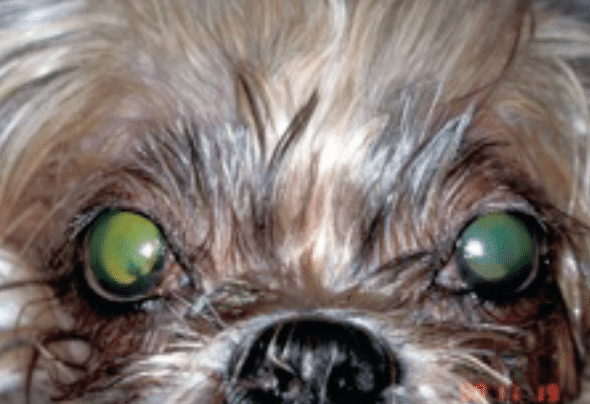What is Keratoconjunctivitis Sicca or Dry eye syndrome?
KCS is the abbreviation for “Keratoconjunctivitis Sicca”, the medical term for dry eye. When there is either inadequate tear production or distribution of tears, the eye surface becomes desiccated or “dried out”. Signs of KCS may include a red eye, squinting, crusty and / or mucoid discharge, or dull appearance to the cornea (clear outer dome of the eye).




What is so important about tears?
The surface of the eye is covered by a thin layer of tears which perform several essential functions. The tears keep the surface of the cornea wet so that oxygen can be taken into the cornea, rinse the surface of the eye clean, lubricate the eyelid movements and help control infection. When these actions are missing, the cornea is deprived of oxygen, irritated and prone to infection. The result is severe, sometimes permanent damage to the cornea.


What causes KCS?
The most common cause in dogs (75-80%) is immune-mediated inflammation of the lacrimal (tear) glands. Others include allergies, infections, hormonal deficiencies, injuries, abnormal growths, nerve damage, and certain medications that can decrease tear production from the glands or interfere with normal distribution of tears.
What treatment is there for KCS?
Treatment must include both replacing the missing tear functions and stimulating more of your pet’s own tears. Some patients respond well to medication administered only 2-3 times daily, while others may require more frequent treatments to keep the eyes as healthy as possible. Of course, if the underlying cause can be identified it must also be treated.
Once KCS is diagnosed, medical treatment is instituted. The most frequently used medication is topical cyclosporine (CsA), which reduces tear gland inflammation and stimulates tear production. CsA is successful in increasing tear production in the majority of patients with immune-mediated KCS.
Patients with very low to absent tear production respond less predictably to CsA, have more complex treatment regimens and may require surgical management to preserve vision. Medications additional to CsA that may be prescribed include topical antibiotics, artificial tear supplements, and eye washes. Recently, topical tacrolimus has been used in certain patients as an alternative to CsA. Patients with inadequate or waning response to CsA may respond better to tacrolimus. Also, tacrolimus can be more effective in stabilizing / reducing corneal pigmentation and scarring associated with long-term dry eye.
Topical antibiotics are used to treat the secondary bacterial infection that often develops as a result of inadequate tear production. Artificial tear supplements are used in KCS patients when CsA therapy alone does not stimulate enough tear production. Eye washes are used to remove thick discharge from the surface of the eye, as well as trapped dirt, pollen and debris within the eyelid folds. When using an eye wash, use it before applying medications to the eye.
Once a patient has KCS, medical therapy will alleviate the signs but will not often cure the disease. Affected dogs and cats usually need to be treated for life. Fortunately, most pets can be maintained on once to twice daily treatments with CsA or tacrolimus.
Some do not respond to the medical treatment and therefore a surgery can be performed (transposition of the parotid duct) in order to bring saliva to the eye as tears are missing. It is not an ideal situation (saliva is not like tears) but it can provide sufficient moisture for the animal to be comfortable.
What can I expect after treatment?
In many patients, once tear functions are restored, the surface health of the eye will improve and the cornea will regain its normal transparency. In other patients, there is some permanent scarring (cloudiness) and pigment that remains on the cornea.
How long does treatment take?
Replacing the missing tear functions and improving your pet’s own tear production can take a few days to several months. However, most patients with tear deficiency will need some type of therapy for the rest of their life.

